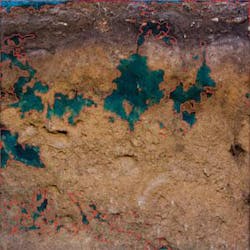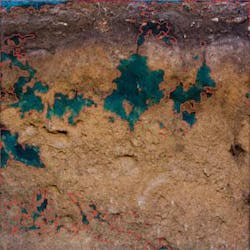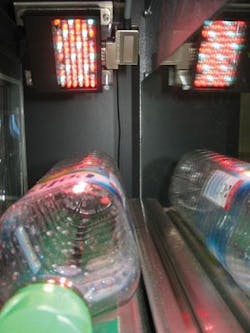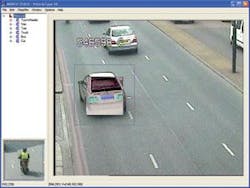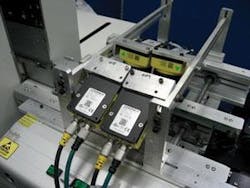Snapshots
Imaging groundwater contamination
Understanding the risk of contamination spreading through soil enables better control and remediation. Dye-tracer experiments have been a well-established method of studying the flow of contaminated water in soils, and a recent study by researchers at the University of Bayreuth (Bayreuth, Germany; www.uni-bayreuth.de) advances this technique. Bernd Huwe and his colleagues Christina Bogner, Benjamin Wolf, Andreas Kolb, and Iris Schmiedinger from the soil physics group have developed an image-analysis method to study dye-tracer results in soils of the vadose zone, which extends from the ground surface down to the water table.
Image analysis is performed using HALCON from MVTec Software (Munich, Germany; www.mvtec.com). The researchers used brilliant blue FCF dye tracer because of its low toxicity and good visibility against a large number of soil colors. Since the principal data acquired are digital photographs of stained soil profiles, special emphasis was given to analysis techniques such as geometrical image correction and image classification. MATLAB from The MathWorks (Natick, MA, USA; www.mathworks.com) was used to extract dye coverage data, which serve as qualitative characteristics of flow dynamics and as input for a stochastic model that estimates the risk of vertical solute propagation.
Recycling packaging waste
Germany’s strict deposit system for disposable beverage packaging now requires most store owners to accept all beverage cans and bottles, even if they were not purchased in their store. To support this system and prevent fraud, a new deposit logo was introduced so that store owners can differentiate between German and foreign packaging. An IR procedure was defined and a tight timetable set to develop a reader for the deposit system.
Since the manufacturer of the reverse vending machines could not develop a reader to support the deadlines, Matrix Vision (Oppenweiller, Germany; www.matrix-vision.com) developed a modular system based on its mvBlueLYNX technology. The Security Mark Reader (mvSMR) smart camera unit can process the acquired images directly and control the different exposures to recognize the deposit logo. Since the reverse vending machine only needs to receive the positive or negative result from the camera unit, existing machines could be easily retrofit with the new system.
Vehicle identification
Machine-vision specialist Firstsight Vision (Tongham, UK; www.firstsightvision.co.uk) has applied a well-established image-processing method to real-time vehicle-recognition applications. In the first application, the class of vehicle (for example, motorcycle, car, van, truck) is identified, while in the second, the vehicle manufacturer can be determined. Both methods can be linked in with license-plate-reading systems.
The analysis is based on an object-recognition tool that uses statistical learning theories. Promising results have been obtained in some preliminary trials, and the company now needs to work with a dedicated partner to ensure that the appropriate traffic-monitoring criteria are met. Potential applications for the systems include congestion charge monitoring and other road toll applications, traffic surveys, and monitoring of secure car parks. The pattern-recognition tool, Manto, is part of Common Vision Blox from Stemmer Imaging (Puchheim, Germany; www.imaging.de). In a pilot study, 900 vehicles were used for training purposes, and the resulting classifiers used on a similar number of vehicles. An accuracy rate of 85% was achieved, with a 95% rate considered a realistic target.
Music players get better read rates
In Malaysia, Sony sought a barcode-reading and traceability solution for printed-circuit boards (PCBs) fused in MP3 players. This kind of product tracking is essential to protect against costly recalls and product mix-ups, as well as to allow for damage control in the event of a problem. With its old code-reading system incapable of meeting the demands, Sony installed In-Sight 5110 cameras from Cognex (Natick, MA, USA; www.cognex.com).
Each PCB passes along a conveyer on nine production lines and is marked with a 2-D Data Matrix code containing product information in 10 characters measuring 1 × 1 mm. Production volume at the plant is 40,000 units a day, and so the reading solution deployed must guarantee a read rate of 100% to allow the production line to eliminate downtime. The serial number marked on each PCB must be identified and tracked. If the code reader cannot adjust to the product changeovers on lines, a serial number can be missed and data lost. No two read points are the same and the lighting, environment, or the way the piece is presented can differ greatly.
Code-reading time is now 2 s/read. The code-reading success rate has increased from 95% to 100%, and the nine lines do not have to stop for product repositioning or focus adjustment. These factors are saving Sony approximately $5000 a week.
